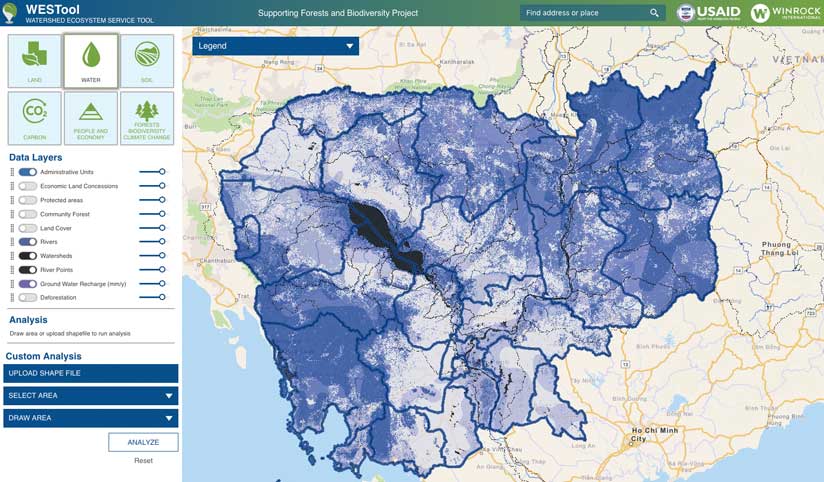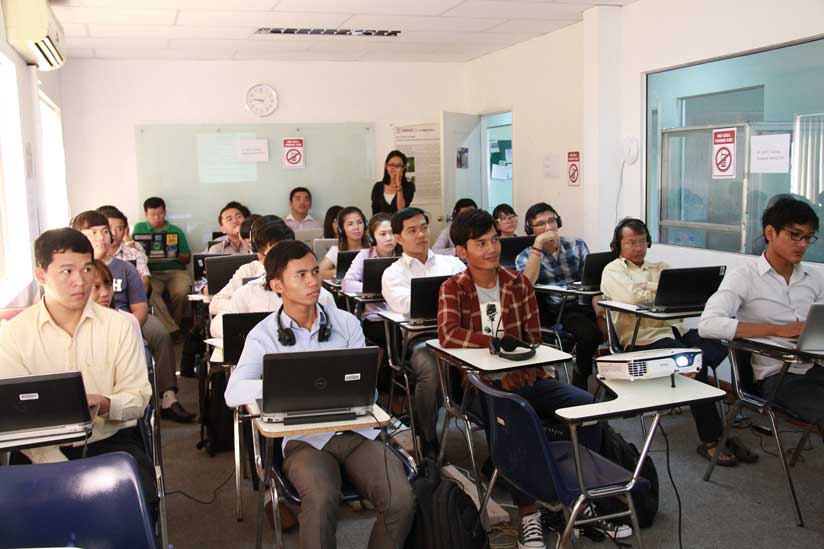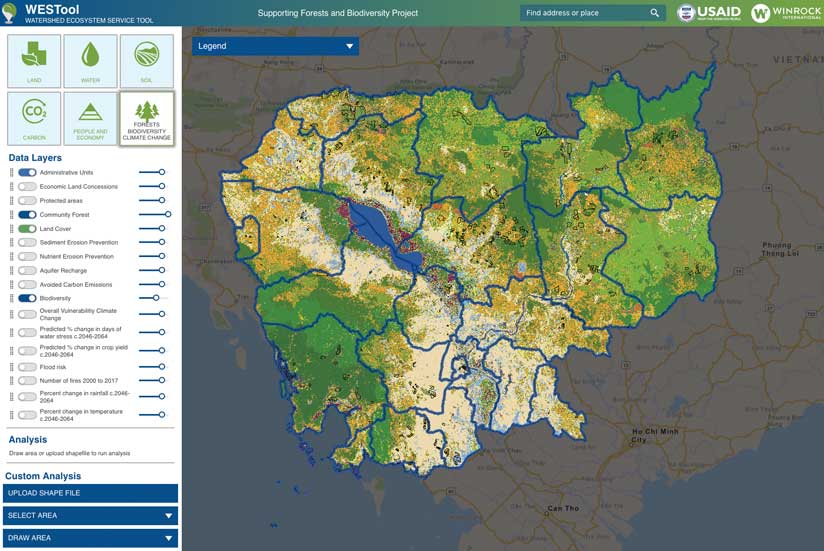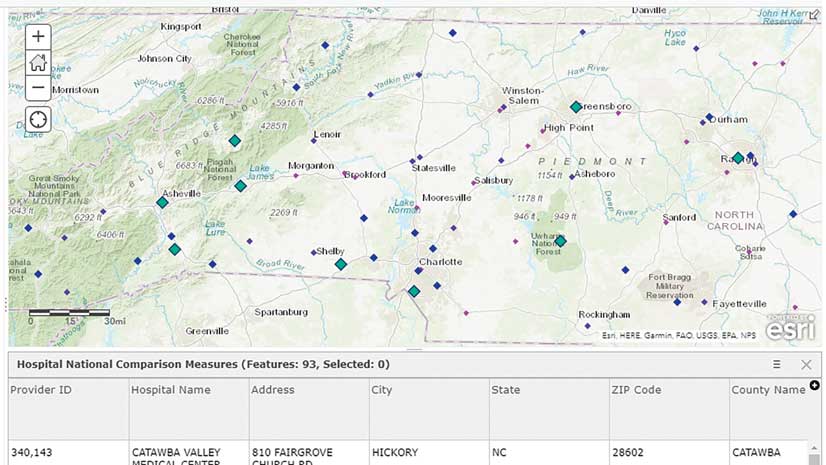Cambodia stands at the crossroads of economic growth and natural resource preservation. It has a vibrant young population, one of the highest rates of deforestation of any country on the planet, and significant development challenges.
Private sector interests in cash crops, timber, and textile mills compete with Cambodia’s need to feed its people and protect its natural resources. Government decision-makers must try to balance private investments with sustainable development goals. It has been difficult to compare the potential benefits and costs of development options because decision-makers lacked information.
But three years ago, the nonprofit organization Winrock International stepped in with a digital tool it designed using Esri software. The Watershed Ecosystem Services Tool (WESTool) was carefully conceived with detailed stakeholder feedback and consultation to make a real difference in the health of Cambodia’s fragile ecosystems.

The WESTool allows users to explore how ecosystem services, land uses, and socioeconomic factors interact across Cambodia’s landscapes. By combining advanced science with intuitive maps and tools, the WESTool offers valuable information at the local, regional, and national scale to support decision-makers and land managers who wish to understand and balance the value of remaining forests with development goals.
Winrock, with more than 100 agriculture, environment, and social development projects in more than 40 countries, has been using Esri software for 20 years. Its Ecosystems Services unit uses Esri software for all its work.
WESTool grew out of Winrock’s Supporting Forests and Biodiversity project, funded by the US Agency for International Development (USAID). Winrock scientists worked with Cambodians to identify their major development challenges and goals, then used Esri software to design a tool that could anticipate changes in water availability, sediment and nutrient loss, water pollution, and greenhouse gas emissions to determine the best policies and practices for agriculture and land management. By bringing together many different types of spatial information, modeling effects, and presenting this information in a nontechnical format, Winrock scientists created a web-based tool that uncovers the impact of widespread land-use change and suggests strategies to stop deforestation.
“The application is unique because it provides decision-makers with a tool to assess the impacts of forest loss on ecosystem services,” said Mike Netzer, a GIS and remote-sensing analyst with Winrock. “Many decision-makers understand there are environmental risks, but they have never had a tool or any way to quantify them. By combining technological advances with a deep understanding of the challenges facing national and local governments, WESTool helps Cambodians make informed decisions to balance economics and the environment.” Netzer helped introduce the tool to Cambodians, and everyone—from government ministers to students—learned to use it.

Seeing Potential Impacts
Three years after Winrock introduced the WESTool, members of Cambodia’s Ministry of Environment use it to monitor water pollution and sedimentation in the watersheds that feed the Mekong River, where there are many fisheries. They also use the tool to predict greenhouse gas emissions from deforestation in the beautiful and protected Prey Lang landscape, where logging is forbidden but still happens.
“The WESTool is a great resource for the Cambodian Ministry of Environment and the Ministry of Natural Resources and Rural Development as we create our state of the environment report,” said Vina Touch, director of the Department of Geospatial Information Services of Cambodia’s Ministry of Environment. “We plan to use it for environmental reporting and integrate it into the geospatial portal currently under development.”

Local communes use the WESTool to create land-use plans and evaluate how dams, roads, and other land-use decisions will affect the landscape. “Just by clicking on the tools in the WESTool home page, we can see potential impacts regarding land use, deforestation, drought, or flood modeling,” said Ley Phanna, chief of the Planning and Supporting Communes office in Stung Treng Province, Cambodia.
It’s difficult to understand the impact of land management decisions without proper, unbiased, science-based information, said Lara Murray, a low-emission development expert with Winrock’s Ecosystems Services team. That’s what the WESTool provides.
For example, Cambodia’s Tonle Sap Lake, one of the world’s largest freshwater fisheries, is surrounded by extensive agriculture but also significant remaining forests. WESTool shows that since 2000, more than 19 percent of the forest in that watershed has been lost. This has caused an increase in sediment and nitrogen loads in the lake. WESTool users can also look at how future changes will affect the lake.
Just a few years ago, if this type of analysis had been done at all, it would have only been done for select locations and select purposes. The results would have only been accessible to scientists and a few government officials. Because it would have required an expensive analysis, likely be localized to a specific area and issue, it would not have taken into account the overall landscape.
Democratizing the Data
“The point of WESTool, originally and always, was to provide an objective platform for Cambodians to evaluate what is happening to their landscape and the impacts of it,” said Dr. Sarah M. Walker, director of Winrock’s Ecosystems Services team. “We’re at a point in history where we have all this amazing data and all this amazing computer power, and that has finally started to reach other countries below the national level, at provincial and local levels.”
Walker said that what technologies like WESTool offer developing nations is nothing short of revolutionary. “Often in the past, things were done because some group was advocating for them to be done, not because it was the most pressing problem. WESTool democratizes the data, placing the power of information into the hands of all the people of Cambodia.”
As countries like Cambodia start to integrate UN Sustainable Development Goals (SDGs) into their development planning, WESTool can also act as a platform to help them plan, implement, and monitor key indicators. The ability to assess SDG baseline conditions and monitor them over time can improve the potential for multilateral SDG financing, which can catalyze sustainable development.
“Developing countries have to prioritize. They can’t just say, ‘We’re stopping all deforestation.’ They need to know where the effects of deforestation and degradation are the worst,” said Winrock president and CEO Rodney Ferguson. The Cambodian government can use the WESTool to determine that deforestation has altered the water cycle in the southwestern part of the country and that they are not only losing more topsoil through erosion but also seeing less water infiltrate into the aquifer because of decreased tree cover. These changes show decision-makers that forest loss has livelihood and economic impacts. “Then they know that whatever they do, they cannot ignore deforestation and degradation in the southwestern part of Cambodia,” Ferguson said.
WESTool has been used to evaluate ecosystem services for 80 percent of Cambodia’s land area, home to 8.7 million people. And Winrock continues to improve the tool through its USAID-funded Sustainable Water Partnership, working with Cambodia’s Ministry of Environment to promote the tool in environmental impact assessments and commune development plans and to assess water security issues in the Stung Chinit watershed north of Phnom Penh. As users gain experience including WESTool in their planning processes, Winrock is incorporating additional ecosystem services, problem domains, and economic sectors. WESTool is eminently scalable to other countries and terrains.
In 2016, the Cambodian Ministry of Environment honored Winrock with a once-in-a-lifetime award. The Royal Order of Sahametrei—the highest honor the country bestows on foreigners—recognizes outstanding service to the king and people of Cambodia. Winrock was singled out for conserving Cambodia’s biodiversity and forest resources, which included its use of WESTool.
What’s most exciting about WESTool, say the people who created it, is how it puts a wealth of usable data in the hands of ordinary people. “It brings people science in a way they otherwise might not be able to access,” Murray said.

